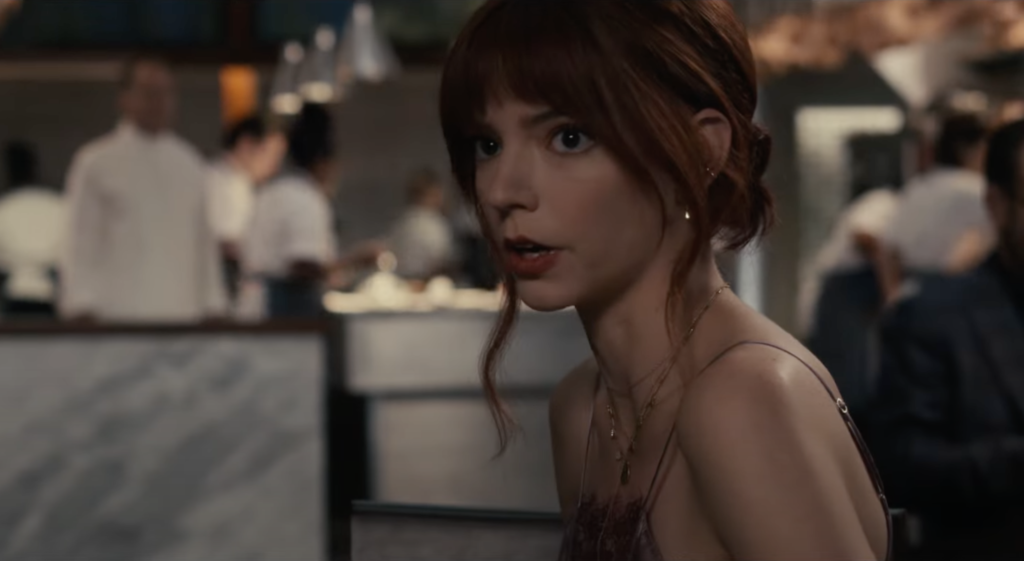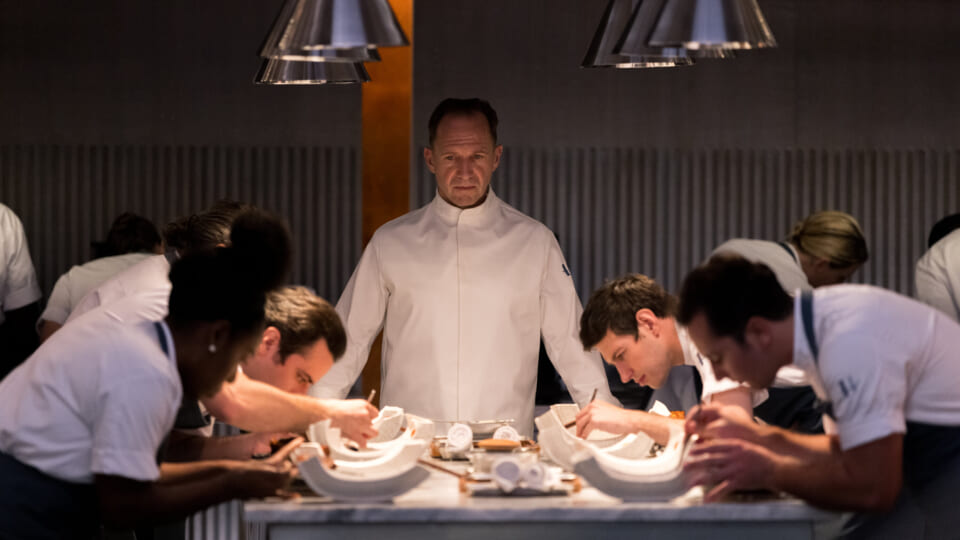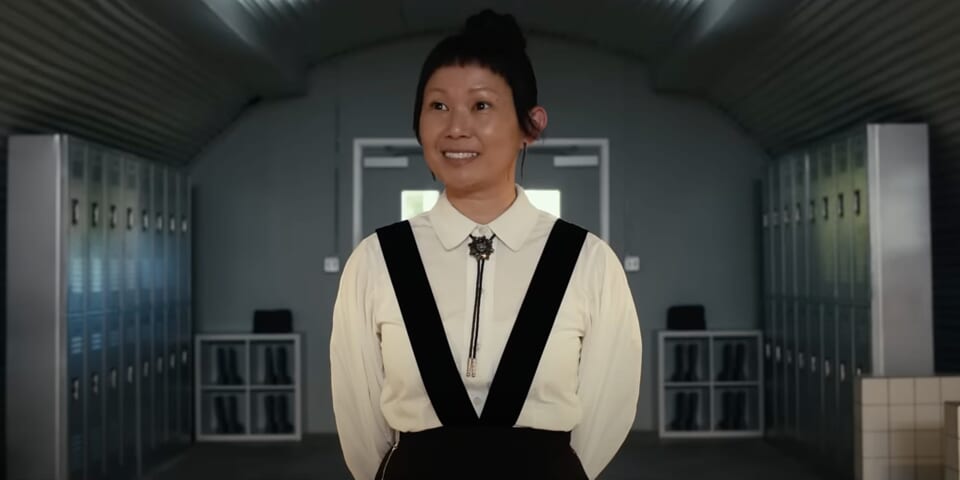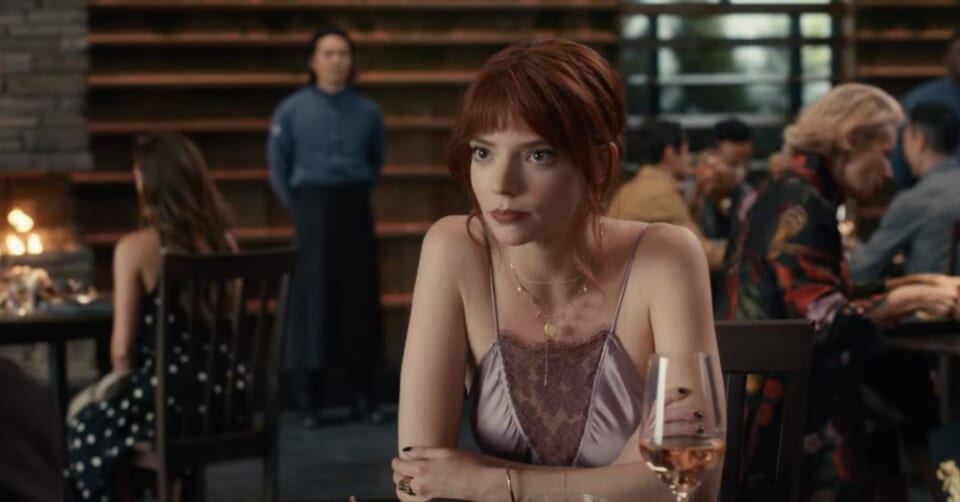Composer Colin Stetson on His Delicious Score for ‘The Menu’ [Interview]

In the new Searchlight Pictures film The Menu, director Mark Mylod trades in the board rooms and family drama of his hit series Succession for the world of chef’s coats and haute cuisine. Co-written by Seth Reiss and Will Tracy, the film delivers a delectable blend of high-class horror and biting humor. Served up perfectly on a silver platter, The Menu uses these elements to cleverly discuss art, artistry, ego, entitlement, the fan, and the critic. A potent cocktail of ideas and tones, it is ultimately The Menu’s brilliant score from Colin Stetson that unites them all with his own unique sonic essence of deliciousness.
In the film, Anya Taylor-Joy (The Witch) stars as Margot. This particular evening, Margot accompanies Tyler (Nicholas Hoult) to a very exclusive restaurant run by the famous Chef Slowik (Ralph Fiennes). Housed on a remote island, this destination restaurant attracts all kinds of wealthy people for highly curated, themed, multiple-course meals. However, things quickly start to spiral when the customers realize Chef’s theme for the night turns them from patrons to participants.
An accomplished studio and solo saxophone player, Stetson’s years of collaboration with diverse artists like Tom Waits, Bon Iver, Lou Reed, Laurie Anderson, Angelique Kidjo, and LCD Soundsystem laid the foundation for his entry into film scoring. Highly talented and attuned to the breadth of emotional resonance that music can have, Stetson quickly garnered a reputation for his out-of-the-box thinking and intuitive and innovative approaches to scoring films. Though likely best known to horror fans for his work on Hereditary, Color Out of Space, and Texas Chainsaw Massacre (2022), Stetson’s arsenal of musical skills knows no genre or format bounds.

It is this assemblage of talents that made Stetson such a perfect choice for The Menu. Dextrously navigating the film’s careful balance of humor, horror, and the reveal of information, Stetson plays brilliantly with aural expectations and associations. A bit different than any of Stetson’s previous film works. The utilization of strings, vocals, percussion, recurring motifs, and sweeping soundscapes add a lavish aura to the film that evolves as it unfolds. Rich with nuance, meaning, and impact, Stetson’s score for The Menu rivals anything Chef could possibly conjure up.
Dread Central recently had the privilege of speaking with Stetson, where we took a bite into his process and approach to The Menu, scoring, and so much more.
Dread Central: The Menu is your first collaboration with director Mark Mylod. How did you first become involved with him and this project? Looking at his career, he seems like a very interesting creative to work with.
Colin Stetson: He’s also very, very funny. I’m speaking for them, but before they approached me, Mark and the editor Chris [Tellefsen], had been deep in the edit, and some of my music had made it into the edit. And then more of it made it into the edit. Then they started to think, “Ok, well, this is really working. We should talk to this guy.” So Searchlight [Pictures] reached out and said, “Are you interested in reading the script?”
So, I read the script, and, the script was everything that the movie is. It’s incredibly unique. It’s exactly the kind of thing that I gravitate towards. I’ve not seen that film before. I’ve not seen that story before. And it does it in a way that is really fun. On a nuts and bolts level, it also functions very, very well. The Menu is also super lean, though. Everything that works on screen, everything that propels it is all there in the script. In a sense, reading the script, it practically wrote the music for me. It’s really just so starkly there. So, I wanted to do it from the get-go.
Then they asked if I wanted to meet. And from the first meeting with Mark, it was just fun. Not only because we got along aesthetically and on such a strong level, but the things that I wanted to avoid, certain tropes and certain ways of going about this, he was also entirely on board and had the same instincts and intuitions. Also, just on a personal level, we have a lot of fun.

DC: The Menu is a highly structured film with the story unfolding in tandem with the meal courses. How did that style impact how you approached the music?
CS: Having those gathering points with a long-form percussive or rhythmic quality to it, mixed with the hand clapping that ties everything together, they’re built-in. Usually, you have to search for those in subtle ways throughout the course of a film to give it that. But The Menu has them all very literally built into the action, which is super fun.
Then the challenge becomes how to subvert an expectation with them. How do you not make them something that becomes rote, something that you now know exactly how each one is going to play out. So that really is, “How much do we know at any given moment in the progression of the storyline?”
It’s hard to speak about any of these things without spoilers. But I’m going to speak as though we haven’t been watching trailers and shit. That’s my biggest pet peeve about the world of storytelling. People don’t just get to go and get the story. Because, the experience that I had reading it, nobody said anything about it. I just knew that it was something that I might like.
So with that in mind, the whole beginning is that we know we’re going to have this experience. [We know] that it is a delightful, extravagant, lavish experience, but “it” knows that experience has a secret. So that whole beginning gets to be something that is largely just a delightful, pompous sort of fun romp pointing all in one direction. But because “it” knows that it’s got a secret, it can’t wait. There are little ways of pulling on threads that I did just to wink at that.
And then, there is that inception moment where, for me, on the page, it was all there. Musically speaking, I saw this very clearly from that first read. I basically had a caged beast in the wings waiting for that moment to just completely change the face of the score and its entirety at that point. You rarely get that opportunity.
Instead of gradually unfolding, [this is] something that is pretty much intact with little hints and then just an entire deluge of “Now this is all completely different.” Anything that comes back from before is now in the context of this new knowledge. Because it is recontextualized now, it has a completely different connotation. It has a completely different meaning. All of these landing points, the different courses, I needed to make sure that the score was very self-aware. Not only of what it was doing, but also what we were privy to at any given moment and where we were emotionally at any given moment.
DC: This score feels slightly different from your other works. You are well known for your incredible saxophone abilities and infusing that into your scores, but this is very string-heavy. Talk a little bit about that decision and writing for strings.
CS: I listen to a lot of music across all different genres and eras, and I don’t think too much about it as writing for this or writing for that. I write in unconventional ways and also in more conventional ways. I think that my friend and collaborator Matt Combs, who plays all the strings, will definitely attest to the fact that sometimes when I write for strings, string players aren’t thrilled with what I write for them. [Laughs] There are certainly moments where I’m like, “Here. Play this.” And he’s like, “Ok. Give me several years.” [Laughs]
For me, I hear a certain aesthetic that’s coming through the characters of instruments. A violin played conventionally is going to be able to function in this, that, and the other way. A string section doing something that’s a little bit less conventional and a little bit less obvious can conduce yet other things. It really is just a kind of searching.

All these things are puzzles. When I have a new script and a new score to write, first and foremost, the puzzle is, “What’s the world build? What are the basic pillars? What is it made out of?” So for something like this, the skeleton is the pizzicato strings. That’s the bulk of all the rhythm, the propulsion, the drive, and all of that is built into that skeleton. That’s played by orchestral strings but also by pizzicato piano and a little bit of percussion to modify, magnify and enhance those things throughout.
So, that’s one. Another one would be the arpeggiated saxophone layers. They create a dreamy, dramatic sincerity to certain things that are emanating from Chef. Another pillar is maybe where I took an instrument called a nyckelharpa, which is a traditional, keyed, stringed instrument from Scandinavia. I played it in a way that I’m sure all nyckelharpa players will not recognize. But that is the face of the bestial cat that’s let out of the bag later on in the story.
It’s finding and first identifying what [those pillars are] and then how I can go about doing this in ways that are going to play to expectation and play against expectation in certain ways. That way it can be familiar enough to bring an audience in but unfamiliar enough that they’re in some way laid off their guard, put off balance. Then I can maybe try to actually elicit a real emotional response from them rather than let them get caught up in autonomy.
That, to me, is the whole thing. People are just inundated with storytelling. They watch the same stories over and over again. They watch the same methods of that storytelling, and everything has a score. The vast majority of those scores are then using the same instruments for the same ends. The same kind of melodic devices, the same kind of rhythmic devices, all these same things.
So utilizing certain aspects to engender a kind of familiarity on the front end is good and helpful. But it’s also making sure that it’s only that much to try and get a foot in the door, as it were. But, then, try to subvert that so you can really get an honest reaction out of people’s feelings rather than them settling into the same train car that they’ve been in a million times and just letting that thing happen to them.
DC: That is an interesting point. It’s one Chef Slowik also brings up early in The Menu when he says, “Don’t eat—taste.” Thinking about that idea in relation to film music, hearing versus listening, is intriguing as it is part of a larger art form. I’d be curious to hear your thoughts and opinion on that.
CS: That’s a good one. We all know when we’ve seen something—I’m thinking of one of them right now—where you’re watching something, but your mind is entirely in the theme of the score. To me, that’s the kiss of death. The score attracted so much attention to itself that you’re no longer with your character. You’re no longer in the world that the narrative is.
I’ve used this analogy a few times in the past about various things, but I feel like it still rings true. When you get the script, when you get the picture, you see the painting, and you see the brush strokes there. I feel like if I’m doing my job right, all I’m doing is extending those brush strokes in ways that enhance, magnify and convey the effect, the narrative, and the intrigue. But ultimately, you’re serving the picture. As soon as you walk in front of the picture, you’ve lost the thread and the point of it all.
I used a lot of big, broad, sweeping themes, but in ways where a sweeping theme will happen when we are having a moment with someone’s inner storyline, their emotional experience. Getting real nuts and bolts about it, there is a moment where Anya is walking, and we have a strong melodic moment. We are pouring into her eyes. Then the theme itself comes out. We don’t hear the theme as, “Oh, that’s such a lovely theme.” We simply experience it as her in that emotionality. So, I always try to play with things to make sure that I’m never really jumping out of the screen, never getting in the way of things. I’m always trying to just push what’s there already and make it a little bit more vibrant and a little bit more felt.
DC: Not surprisingly, the kitchen plays a big role in this film and overflows with various sensory elements. Did any of these make it into your score or influence any of your creative decisions?
CS: One of the ways is the very polyrhythmic math-y foundation for everything. That was one of the first things that I thought of. If you sit adjacent to a kitchen, you’ll hear this kind of cacophony which, when not focused on, can just sound like white noise or chaotic dissonance. But when focused on, one can make (more or less) order out of it, or some semblance of order.

So that approximated in music, to me, was a highly polymetric math-y grid of interlocking percussive elements. So rather than having that just be pots and pans that are rhythmic and counter the pots and pans in the foley, I [approached it differently]. It really was to have the meat of that be filtered through the melodic and the harmonic. So most of that idea was then placed into the strings and the piano.
I did then use things like water glasses, pots, pans, and some old utensils. Things that just had beautiful sonic qualities and colors to them. But I tried to use them in ways that were a little non-intuitive. So for certain scenes, I’d say the ultimate last bit, which I won’t talk about in any real way, but that last course, that ultimate climax of the film there, it just keeps growing and burgeoning. To me, it’s this very churchy, very reverent cathartic exultant moment.
One of the things that I love is metal. And, I get a lot of questions about how this is very classical-driven. But the meat of the whole score is more akin to something like Meshuggah than it is to classical music. It’s just got a different face on it. To me, if I was playing that orchestra at the end there, I hear black metal cymbals and this blast, bigger, and bigger and bigger. But there are no black metal cymbals in this film. That doesn’t exist.
But, we got Greg Fox (Liturgy, Zs), one of the world’s premier black metal drummers, to then come in and use an array of water glasses and just tear on that. Then we have a number of those layered on one another. So that last scene, the shimmer that starts to happen and grow and grow and grow, that kind of pointillistic, starry sound is just Greg playing glasses. Things like that are always my favorite thing to do in scores; using less obvious means to more certain ends.
DC: Wow, that subversion is not only extremely cool but also quite humorous. It fits right into this film’s mix of horror and incredibly clever dark humor, which, to be honest, I was not expecting. But it’s so funny! How else did that humor element work influence your approach?
CS: I love that. And I agree. Getting very technical, the percussive rhythm, that rhythmic throughline, is the DNA that ties the whole film together. It really does everything. Played on orchestral strings in the very beginning, it establishes this little subversion of expectation. It makes us feel as though it itself is delightful. There’s a levity to it. It feels extravagant. It feels lavish.
But those same rhythms, that same approach, once certain moments happen, played on different instruments and now layered in ways which are a little bit more stark and exposed, now those things don’t convey that at all. But later on, we can take the earlier iterations and place them in this new context. The fact of that juxtaposition in itself can be funny.
Also, if we have a certain rhythm happening and we lay over an entirely different one, when certain things line up, just like pulling the switch on a train track, that thing that we saw going straight forward for miles and miles all of a sudden veers to the left. So to me, reading the script, it seemed like this approach was going to accomplish all the things. It was going to be the drive, the anxiety, and the comedy all in one, just utilized in different ways.
DC: There’s a character in The Menu played by Nicholas Hoult who is a foodie and knows all the lingo but isn’t necessarily a great cook. And, I’m going to be honest, I felt a little called out. I mean, here we are today, digging into your craft.
As an actual artist, do you ever feel like too much examination or discussion around the artistic process—including composing—dulls or strips away some of the magic? Is there any part of the process you keep to yourself?
CS: I don’t do this a whole lot, so…I don’t know how to say this. It’s not that I feel like it demystifies. I speak about things in the ways that I would like to speak about them. I do talk a lot more technique forward and process forward, the nuts and bolts. I’m not particularly precious about that stuff.
I don’t seek out a whole lot of talking about my music. It isn’t that I don’t believe in it. I’ll represent certain works and talk about them in terms of their fundamentals. And I’ll gleefully do that. I love doing that. I don’t like to talk about, “What kind of music is this? What genre are you? How do you see your music? How do you see yourself?” [I don’t like] those kinds of approaches or anything that has to do with me. That doesn’t show up. We’re not doing that, especially in a score situation. It’s storytelling.

I feel like what we’re doing is telling distinct stories. And for me, the music, I will uphold it and represent it and talk about it all day long. But not with regard to what it means to me or how I’m implicated in it. Because it’s not about me. I take that for everything: solo music, scores, everything. Ultimately, after it’s made and it’s out there, I want it to be an object that gets to be autonomous and gets to live outside. I don’t want it to be implicated by anything other than the listener having an experience with a sound source that is, hopefully, telling some amount of a story.
Glenn Gould said, “To me, the ideal audience-to-artist relationship is a one-to-zero relationship.” He became obsessed with the idea that recorded music, and specifically the CD, was the perfect relationship between a musician and an audience. I have always held that very, very dear. I know that with all these things, we’re selling stuff. There is that whole aspect. So, I show up. But if I had my druthers, in that fantasy land, it’s pitch black on stage when I’m playing. And I never show up in pictures. [Laughs]
DC: I love that you brought up the CD and that idea because you’ve had your film work physically released multiple times now on both CD and vinyl. What are your feelings on physical media? Does having something released physically feel different or mean more to you personally than a digital release?
CS: It’s very different. And I would always wish for it. I was just talking to someone (also a musician) about [how] this moment we’re in feels transitory. And, we know what happened. Spotify and all the majors decided to make this awful deal with no foresight to sell everybody out in perpetuity and then go, “Whoa. We don’t even know what it is that we just did in terms of revenues. We didn’t do any analysis, and now we have no idea.” And guess what? Music is not only devalued in the eyes, hearts, and minds of every person going forward and the world view, but it also has no monetary value. And in some senses, there’s less of a tangible, direct tether to it.
I’m definitely gonna go off on an in-my-day-old-man rant right now. We’re talking about in aggregate and about the vast majority of people. One’s relationship to an object, it does mean more. And to music, a singular bit of storytelling. It means more when you’ve invested more in it. It always does. I mean, we hear about these stories of mid-century Soviet-era people trying to make punk music and printing vinyl records onto old x-ray things, smuggling them from person to person, playing them quietly, knowing it was so subversive that it could mean they could go to fucking prison for the rest of their lives. I’m sure they had a full-body, full-person emotional response to that music because of how much was in the act of it. That physical object was imbued with so much; it was so charged.
And, we’re not even talking about anything like that. We’re talking about going to a record store. Leafing through and finding something that maybe you’ve heard of a little bit or looks interesting. “Huh. I wonder what this is going to be like. I’m going to take the $30 that I have this month for records, and I’m gonna buy this one and one other one. I’m gonna bring ‘em home.” And then you listen to them, and maybe you don’t like them the first time. You give it a little bit more, and maybe you never do. That one maybe just goes to the used place. But maybe, because you sat with it, it’s something that grows on you, and you now know a kind of music that you wouldn’t have known before.
There’s a certain kind of thing that has happened with accessibility being so easy. A minority of people, the searchers, are the people who really do use the pathways to search out all the things that can be searched out. And it is profound, the internet. The internet is not at fault. It’s what huge moneyed interests have done with the internet to basically make sure what they’ve always done continues to happen—they funnel as many people through as few pathways as possible.
I don’t think that it is simply nostalgia or romanticism about it. I think that there is fundamentally something that is very romantic, something that is very human about imbuing an object with a kind of power and emotionality of itself. We’ve been doing that since before we had what we think of as religion. The initial spirits were all in objects. So, I don’t know. It’s a huge one for me. I couldn’t feel more strongly about it. I’ll always make wherever, whatever I can. I’ll always be making records and making objects to try and further that cause.
The Menu is currently playing in theaters nationwide. In addition, Stetson’s score for the film is now available to stream on all major streaming platforms and physically on vinyl from Milan Records and Waxwork Records.
Categorized: Interviews News
